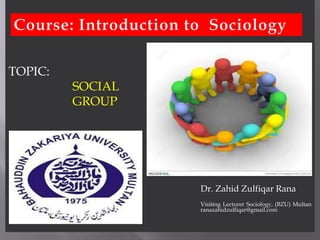
Lecture of Sociology on Social Group
- 1. TOPIC: SOCIAL GROUP Dr. Zahid Zulfiqar Rana Visiting Lecturer Sociology, (BZU) Multan ranazahidzulfiqar@gmail.com
- 2. “Group is a collection of two or more individuals who are switched on for a longer time on the basis of common expectations and mutual relationship”(F. E. MERILL ). “Whenever two or more individuals come together and influence one another, they may be said to constitute a group” (Ogburna & Nimkoff).
- 3. Collection of Individuals Interaction among Members Mutual Awareness We-feeling Group Unity and Solidarity Common Interests Similar Behavior Group Norms Groups are Dynamic Stability Influence on Personality
- 5. Charles Horton Cooley (1864- 1929) introduced the Primary Group. According to Charles Horton Cooley “Primary group is a small social group whose members sharing personal and lasting relationships”.
- 6. Mutual intimacy Personal relationship Small size Unity Security Physical proximity Control over members Individual interest is subordinate to group interest Cooperation Similar background Personality development
- 7. MACLEVER used the term of Secondary group in his Book “Society”. Secondary groups can be roughly defined as the opposite of everything already said about primary group (Kingsly Davis). The groups which provide experience of lacking in intimacy are called secondary group (Ogburn).
- 8. LIMITED OBJECTIVES FORMAL AND IMPERSOANL RELATIONS OPTION OF MEMBERSHIP CO-STATUS RELATIONSHIP DIVISION OF LABOUR LARGE IN SIZE GOAL ORIENTED EFFICIENCY WIDER OPPORTUNITY ACTIVE AND INACTIVE MEMBERS
- 9. Primary group has personal orientation Usually long term Broad, families, circles of friends Secondary group is Goal oriented Variable, often short term Co-workers, political organization
- 10. American Sociologist W. G. Sumner in his book “Folkways” has classified group into In-group Out-group
- 11. The group in which the individual identifies oneself is called in-group (Sumner). Is a social group toward which a member feels respect and loyalty.
- 12. Feelings of brotherhood Ethnocentric in nature Creates Solidarity Have Common feelings Have a Love sympathy and fellow-feeling
- 13. Out- group a social group toward which a person feels a sense of competition or opposition. The Group in which the individual does not identify himself is called as out group (Sumner).
- 14. Feelings of hate for the members of out-group Lack of ethnocentrism Lacking the solidarity among members Individual feelings are dominant Lack of love and affection
- 15. It is a group which has formal organization, role and status, people have their entrance which is according to certain rules and regulations and there is a written code of conduct for the group to function. Members are given punishment for violating the rules and regulations of the norms of the group. All the members have roles to play.
- 16. Fixed rules and regulations Written rules Fixed objectives People have formal relations
- 17. UTILITARIAN ORGANIZATIONS: large businesses, for example generate profits for their owners and income for their employees. NORMATIVE ORGANIZATIONS: people join normative organizations not for income but to pursue some goal they think is morally worthwhile. Sometimes called voluntary associations, they include community service groups, such as the Lions Club, Al Khidmat foundation, Youth Organization etc. COERCIVE ORGANIZATIONS: Membership in coercive organization is involuntary. People are forced to join these organizations as a form of punishment (prisons) or treatment (some psychiatric hospitals).
- 18. Formal organization date back thousand of years. Elites who controlled early empires relied on government officials to collect taxes, undertake military campaigns, and build monumental structures, from the Great Wall of China to pyramids of Egypt. This is the example of traditional formal organization. Max Weber, introduced the modern formal organization in the name of Bureaucracy.
- 19. Bureaucracy is a formal organization dominated by impersonal relationship. The workers are hired on the basis of their skills and qualification. There is a clear chain of command. All members are bound to follow the written instructions.
- 20. Specialization HIERARCHY OF POSITIONS RULES AND REGULATIONS TECHNICAL COMPETENCE IMPERSONALITY FORMAL, WRITEN COMMUNICATIONS
- 21. It is that type of group which has no organization and no rules and regulations. Members are scattered and become united when needed. for example, gupshup, people walking in bazar etc.
- 22. INFORMAL GROUP HAS A LOOSE DISCIPLINE AND DUTIES ARE NOT FIXED. NO STANDARD OF ELIGIBILITY FOR MEMBERS OF INFORMAL GROUP. THERE ARE NO FIXED OBJECTIVES INFORMAL RELATIONS
- 23. D. Miller divided groups in to Vertical group Horizontal groups.
- 24. The vertical groups are larger, inclusive groups such a nations, religious organizations and political parties. The horizontal groups are small divisions consisting mainly, of members from , social class, a group of professionals such as doctors, teachers and engineers.
- 25. The horizontal group includes persons of the same status. A nation, for instance, is a vertical group, which a class represents horizontal grouping.
- 26. Quasi-groups are those kinds of social grouping which lack the essential features of social groups. In this kind of grouping, there may be no functional integration among members. There is little or no structured and patterned social relationships. This kind of social interactions is common in Urban heterogeneous settings. They characterize individualistic societies. Such groups lack meaningful social structures and social interaction.